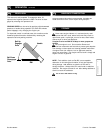
Part No. 890257 Form No. F021695H
Page 6 of 12
OPERATION 6
Note: Frequently empty debris to prevent bag overloading with
more weight than you can lift.
An optional bag and dust cover is available for use where debris will
be vacuumed in dusty conditions (see Optional Accessories shown
on page 1.)
DO NOT place bag on or near hot surface, such as engine. Run
engine at 1/2 throttle f or first 1/2 hour to condition new bag. Your new
bag requires a break-in period to condition the pores of the material
against premature blockage. The entire bag surface ser ves as a filter ,
and must be able to breath to have good vacuum performance.
Be sure engine has come to a complete stop before removing
or emptying bag.
This vacuum is designed for picking up trash, organic
material and other similar debris
(see Safety Warnings page 2-3).
However, many vacuums are used where dust is mixed with
trash. Your unit can intermittently vacuum in dusty areas. Dust
is the greatest cause of lost vacuum performance. However,
following these rules will help maintain your machine's ability
to vacuum in dusty conditions:
•Run machine at idle to quarter throttle.
•The debris bag must be cleaned more frequently. A vacuum
with a clean, pillow soft bag will have good pickup perfor-
mance. One with a dirty, tight bag will have poor pickup
performance. If dirty, empty debris and vigorously shake bag
free of dust.
•Machine or pressure-wash debris bag if normal cleaning
does not fully clean bag. Bag should be thoroughly dry before
use.
Having one or more spare debris bags is a good way to reduce down
time while dirty bags are being cleaned.
•DO NOT leave debris in bag while in storage.
Debris bags are normal replaceable wear items.
DEBRIS BAG
16.316.3
16.316.3
16.3
OPERATION continued
1616
1616
16














